Hawker Siddeley Nimrod - History
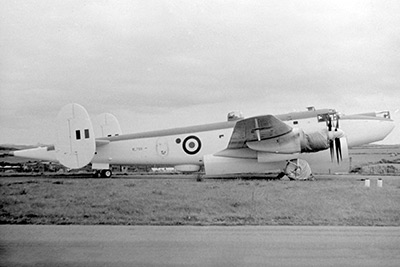
Shackleton MR.2 WL789, MAD boom trials at RAF St. Mawgan, late 1953; Damien Burke collection
Both of the World Wars had demonstrated that our island nation was vulnerable to submarine warfare in particular, and the advent of long-range patrol aircraft combined with excellent signals intelligence had seriously helped in the defeat of WW2's U-boat menace. However, the end of WW2 saw the existing maritime patrol aircraft (MPA) soldiering on until 1951, when the purpose-built Shackleton MR.1 MPA entered service - with an unimpressed RAF. Trials had already found the aircraft unacceptably noisy (inside and out!), and so not only were they looking at immediate improvements (resulting in the somewhat improved MR.2), they were already looking at how the type would be replaced by something more advanced in the 1960s. With requirements for greater range and faster transit times to patrol areas, the Shackleton was clearly becoming a dead end, but efforts would continue to reduce drag and improve take-off performance with higher loads, and various companies looked at drawing up designs for a more effective type that did not handicap its crew with an excessively uncomfortable and noisy work environment. The RAF, however, didn't issue any firm requirements, as they were then in the process of deciding how they would even handle future maritime patrol as an organisation. As a stop-gap to expand the RAF's maritime patrol abilities, P-2 Neptunes were bought from the USA, entering service in 1952, serving alongside their longer-ranged Shackleton brethren.
By 1957, the only result of the RAF's dithering and the production of many paper aeroplanes in drawing offices throughout the UK was the arrival of an upgraded Shackleton, the MR.3, containing some elements of Avro's work towards a newer and more effective type. It was simply cheaper to make some tweaks than build a new aircraft, and any work towards a true Shackleton successor slipped further over the horizon. Later in the year, NATO issued a specification for a new maritime patrol aircraft (NBMR.2) to replace the Neptune then in use by much of NATO, including the RAF. From the various competing designs submitted for this project, Breguet's twin-turboprop Atlantic was the winner and the initial intent was for various NATO nations to standardise on this new type. However, the RAF felt that the NBMR.2 spec and the resulting winner, the Atlantic, wasn't much of a technological leap from the Shackleton, and they had no requirement for such a type. So, while the Germans and French were busy designing and building Atlantics, the RAF were busy toying with specs for yet more paper planes whilst British industry went through an interminable and fruitless cycle of drawing up new designs and sending them to an apparently disinterested Ministry of Aviation.
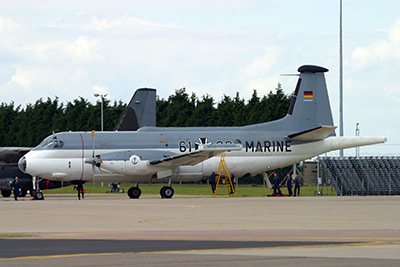
Marineflieger Atlantic 61+20, Waddington, June 2004; Damien Burke
This wasn't an uncommon situation in the 1950s, with Britain short on cash and long on responsibilities, resulting in many paper projects that never saw the light of day. It wasn't until 1963 that the Air Staff finally had a firm idea of what they really wanted for their Shackleton replacement, and the confidence to try and get it from drawings to production. Air Staff Target (AST) 357 was issued in June 1963, which called for an ideally jet-powered MPA with transit speed of 450 kts, 3 or 4 engines, 8 hours endurance on station and a weapons load of more than 18,000lb - and able to operate from runways as short as 6,000ft (such as Gibraltar). Oh, and nuclear depth bombs, Martel missiles, ballistic missile launch detection, advanced wide area radar/IR linescan, an anti-submarine sea environmental prediction system, and much more. This was an all-singing, all-dancing aircraft and it should have been already obvious from the delays being experienced by the TSR2 project that it would be well into the 1970s before it was likely to enter service - if at all. Something needed to be done sooner than that.
With various UK and USA aircraft manufacturers busily drawing up (or resubmitting) designs to satisfy AST 357, it was notable that several were conversions of existing airliner designs such as the BAC 1-11, VC-10 and the Hawker Siddeley Trident. By June 1964 the RAF and Ministry of Aviation had sensibly abandoned AST 357 and decided to go for a less advanced, albeit interim aircraft. It was a kick in the teeth for the UK aviation industry, as the resulting Air Staff Requirement (ASR) 381 was basically the specification for an Atlantic, and that's exactly what they now wanted, having turned their noses up at it years before. The UK aviation industry was not impressed, and after years of wasted effort drawing up MPA designs, who could blame them? Sir Arnold Hall of Hawker Siddeley led the charge, pointing out how the RAF had been asking for steadily more advanced types, rejecting all that was laid before them, and now were suddenly asking for something less advanced than anything previously considered, from a foreign manufacturer. He told them that Hawker Siddeley's Avro division were convinced they could give the RAF what they had originally really wanted - a high performance jet MPA. Their idea was to build a maritime version of the Comet 4C, an idea they had already toyed with back in 1961. This was on the basis that production had only just stopped, it had the required performance, and the RAF was already experienced with operating the Comet. It was a tried, tested and reliable airframe. More engines than a Trident; cheaper than a VC-10. The Americans also offered their P-3 Orion, anxious to ensure that the UK could keep maritime patrol going whilst able to afford enough airframes. A tempting offer for a cash-strapped government.
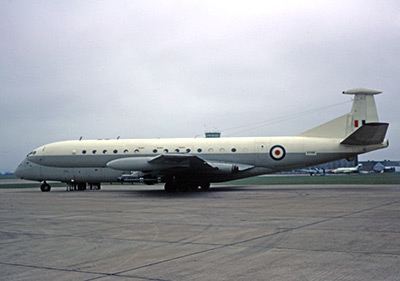
Nimrod MR.1 prototype XV148, Martel missile trials at Hatfield, 1969; Damien Burke collection
However, offering the customer a little more than they asked for, without pushing the bill upwards, usually goes down well, and after a slew of cancellations in early 1965 (AW.681, P.1154 and TSR2) resulted in the UK buying American types (C-130, F-4 and - abortively - F-111), there was also little appetite for further foreign purchases. Accordingly, in late 1965 the contract for the UK's new MPA was awarded to the Hawker Siddeley group and the HS/Avro team got stuck into detailed design work. One thing they made sure of was that they would be in charge of everything and have complete responsibility for the entire system, not just the airframe. The Comet 4C was to be turned into an MPA by fitting less thirsty Spey engines (versus the Avons already in use), crossfeed ducts between the port and starboard engine groups to enable in-flight shutdown and restarts using bleed air from the operating engines, bolting on a lower fuselage pannier to give the necessary room for a weapons bay and search radar, strengthening the wings and undercarriage to deal with higher loading, and fitting various equipment that could be re-used from the Shackleton. The fuselage pannier - giving a distinctive 'double bubble' cross section for the fuselage - called for a larger fin area, dealt with by the introduction of a fillet extension forward of the existing fin. Fire extinguisher pipes were provided for the underfloor bays, with extinguishers to be connected and fired manually if any particular bay indicated high temperatures on its fire warning circuit.
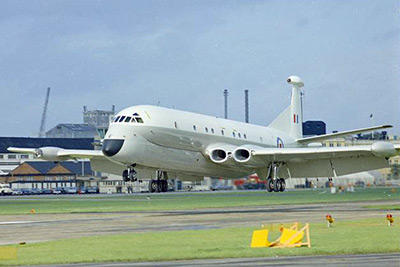
First production MR.1 XV226 at Farnborough SBAC, 1968; IWM RAF-T 9525
The enormous capacity of the weapons bay meant that Nimrod would be able to carry a formidable array of weapons and SAR equipment, with the bay usually containing a SAR pack (air-droppable dinghy and associated kit) as well as any offensive weapons such as Stingray torpedoes. Four sonobuoy launchers were also fitted in the rear fuselage, two of which could be used when the aircraft was pressurised, the other two needing the jet to be flying low and unpressurised. The amount of work to fit all this to an airliner was still considerable, but far faster than designing a new aircraft, and so the first prototype of what was originally the 'Maritime Comet' but now named 'Nimrod' flew on 23rd May 1967, just 3 years after Avro had submitted the brochure.
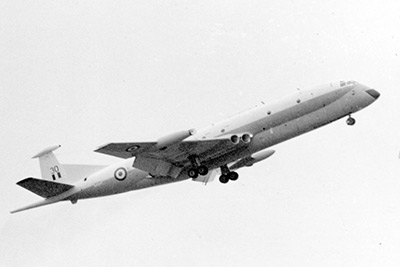
MR.1 XV230, the RAF's first Nimrod, getting airborne from St. Mawgan, 1973; Damien Burke collection
The first two airframes (XV147 and XV148) were conversions of existing Comet 4Cs that had not been sold (only the second of which received the Spey conversion); by June 1968 the first production aircraft (XV226) had flown, complete with its extended Magnetic Anomaly Detector tailcone, to be used to find submarines by the effect they had on the local magnetic field. Flight testing had found the only notable problems were some directional instability so the fin fillet was increased in size (the fuselage had already been slightly shortened to assist in this area too). By this time the first Atlantic production run was coming to an end, and sales efforts included an appearance at the 1968 Farnborough SBAC show which resulted in disaster with the Atlantic crashing during a mishandled low altitude pass with one prop feathered, killing all on board. While the Dutch and Italians still ordered the Atlantic, Nimrod would only ever have one customer - the RAF.
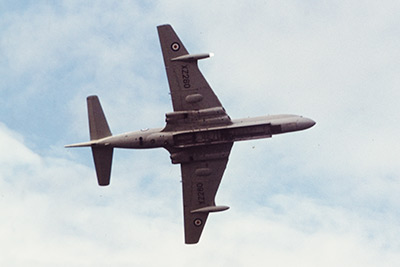
MR.1 XZ280, 1977; Damien Burke collection
The Maritime Operational Conversion Unit (MOCU, later 236 OCU and 38(R) Squadron) was formed at RAF St. Mawgan, and received its first airframe, XV230, in October 1969. The target of getting the new MPA into service before 1970 had been met - and under budget. As production ramped up, Coastal Command were disbanded and the responsibility taken on by No.18 (Maritime) Group, part of the new Strike Command. By late 1972, 38 MR.1 aircraft had been built and delivered, and the type was in service with 42, 120, 201, 203 and 206 Squadrons, based out of Kinloss, St. Mawgan and Luqa. The RAF's secretive 51 Squadron were also receiving three examples of a new variant - the R.1. Delivered to the RAF without any of the maritime patrol equipment (including deletion of the MAD tailcone), these were kitted out with their various highly sensitive reconnaissance equipment away from the prying eyes of the manufacturers of the aircraft. They were expensive beasts to equip, and a follow-on order of another 8 never materialised. The rapid development of Nimrod MR.1 happily enabled a swift retirement of the Shackleton MR.3 force, which was already suffering wing fatigue as a result of the fitting of jet boost engines in the rear of the outer Griffon engine nacelles to improve take-off performance.
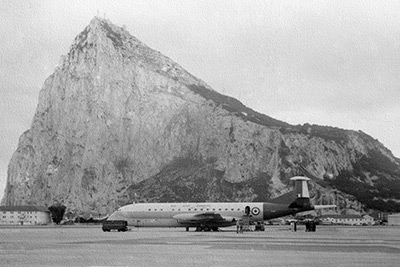
Nimrod MR.1 prototype XV148, Searchwater trials, Gibraltar, late 1970s; Roy Denney
The MR.1 was immediately an effective MPA (detecting its first submerged Soviet submarine in August 1970) but it had most definitely been equipped to a budget and a timescale, so the RAF had already planned on future upgrades to make use of new technological developments. In the meantime, the RAF worked up the new type and in particular found that it's ASV-21D search radar, the same as fitted to their venerable Shackletons, left much to be desired now it was fitted to a higher performance airframe. It was already high on the list of items to be upgraded. The Marconi-Elliott 920B central computer, cutting edge when the Nimrod was being designed, was hitting the limits of its capacity too, particularly when it came to dealing with the volume of data that could potentially be sent back by sonobuoys.
Work on the MR.2 upgrade started in 1975, and it proved to be a substantial improvement on the MR.1, with an all-new Thorn-EMI Searchwater radar (soon itself upgraded with a colour display, and capable of picking up a submarine periscope at more than 30 miles), a new tactical system consisting of a new FM1600D computer with associated 920ATC processors, new AQS901 sonar system compatible with a wider range of sonobuoys and wingtip Electronic Surveillance Measures pods superseding the older system fitted in the 'canoe' fairing on top of the fin. Only one new-build MR.2 was produced; the remainder were all MR.1 conversions, and the first was flown in April 1977, entering service in August 1979, with the last being delivered in 1984. The MR.2 conversions mostly arrived wearing a new 'hemp' overall paint scheme (designed more for concealment whilst parked on the ground rather than in the air). All the new avionic equipment generated a lot of heat and required extra cooling; MR.2s had a distinctive air scoop added to the rear fuselage, and bleed air from the engines was used to run supplementary conditioning packs (SCP), with a new SCP duct added running from the crossfeed pipe in the weapons bay all the way to the rear fuselage, in close proximity to fuel pipework. This was to be a fateful design decision as the opportunity was missed to put any fire detection circuits in this area. Unlike the MR.1, where the crossfeed pipe was only hot during engine start or when flying with two engines shut down, on the MR.2 the crossfeed pipe would be active to supply the SCP whenever the SCP was turned on - pretty much the majority of the time.
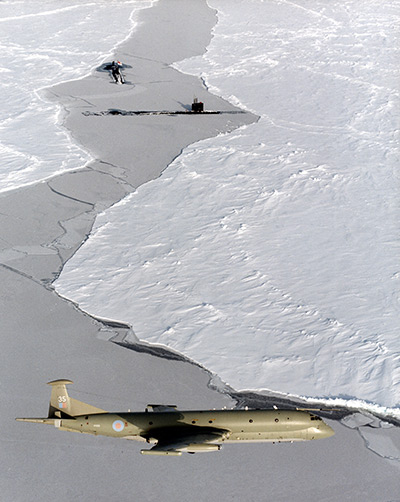
Nimrod MR.2 XV235, submarine hunting, North Pole, 1995; Sgt Rick Brewell/RAF
The Nimrod force wasn't just there to cope with the submarine menace; maritime patrol is just that, endless hours over the sea, carrying out as diverse a range of tasks as the RAF were up for. Nimrods could coordinate air-sea rescue operations (notably during the Fastnet Race disaster of 1979 and the Piper Alpha oil rig disaster of 1988), eavesdrop on enemy communications, and even keep an eye on the fishing fleet. The so-called "Cod Wars" of the 1970s put Royal Navy frigates and RAF Nimrods firmly in the frontline. The R.1, meanwhile, avoided publicity and quietly got on with the job of snooping on the Soviets while the equipment on board was upgraded on an almost continuous basis.
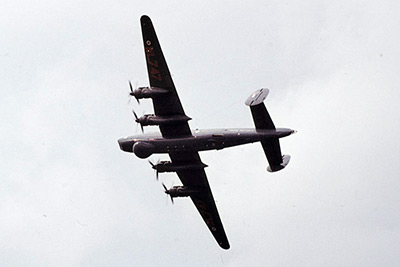
Shackleton AEW.2 WL747, 1980; Damien Burke collection
While the 1970s wound on and the job of the Nimrod force of keeping track of the Soviet navy kept them 'in contact with the enemy' on a daily basis, the RAF found themselves in need of a new Airborne Early Warning (AEW) aircraft and once again looked at replacing Shackletons with Nimrods. The aged Shackletons had been given a new lease of life in 1972, when the Royal Navy began retiring its Gannet AEW aircraft, and the opportunity was taken to fit their equally ancient AN/APS-20 radars to RAF Shackletons. Ancient though it was, it was a powerful radar and a skilled operator could work wonders. However, with the cold war winding up to its height, the slow and outdated Shackletons were fast becoming an embarrassment.
Boeing offered their E-3 AWACS, but British Aerospace pushed another Nimrod variant, to be fitted with new radars in large nose and tail bulges to provide 360° coverage (the E-3 had a blindspot cone below it that expands with patrol height because of airframe masking). In late 1974 the decision was taken to go ahead with work on this new variant, the AEW.3. Unlike the original decision to convert Comet airliners to be MPAs, this was a much riskier course of action as the entire radar system was to be designed from scratch, relying on the production of an advanced technological solution to provide something equally capable to the E-3 but in a smaller airframe with a smaller crew. ASR 400 was issued and was once again calling for an all-singing, all-dancing system rather than something cheaper and simpler. It included several items that firmly ruled out the E-3, such as being able to detect submarine periscopes, though quite why this was necessary when the existing Nimrods did that was anybody's guess. Trials started in 1977 with a Comet 4 converted to carry a large nose bulge to house the radar, and Nimrod fin to counteract the added side area.
The AEW.3 project dragged on into the 1980s and was pretty much a shambles from start to finish. Project management, direction and oversight was chaotic with the GEC/Marconi as the prime contractor on an open contract (basically a blank cheque), which left BAe unable to do much about the systems being placed in the airframe, GEC unable to do much about the airframe, and the MoD apparently unable to understand what on Earth was happening. The addition of the large radomes necessitated various aerodynamic fixes such as additional vortex generators but these problems paled in comparison to those of the avionics. The original spec had called for the ability to track up to 400 targets and direct multiple friendly fighters on to them, with just 4 crew members handling this task, relying upon automation where an E-3 relied upon a larger crew. The hardware and software developed simply wasn't up to the job, and by 1981 trials were showing that even handling 100 targets was a near impossible challenge with operators complaining that the interface to carry out common tasks was unnecessarily complex and unforgiving.

AEW.3 showing off its bulging ends and taller tail, Woodford, early 1980s; Steve Ball
While the AEW.3 had dispensed with the weapons bay and filled the area with fuel for greater endurance, this and the weight of the radar kit had brought the aircraft's all up weight to a perilously high figure, and much of the extra fuel was in reality unavailable for consumption except when flying circuits back at home base, as it was otherwise needed as a heatsink to cool the avionics. More importantly, though, radar performance was abysmal. Hampered by both poor antenna choice and electromagnetic interference from the engines affecting the fuselage wave guides, the radar picture was bedevilled by 'clutter' and there was often no way an operator could tell if a contact was real or not. The entirely inadequate storage of the central computer could barely cope with the quantity of real tracks, never mind the multitude of false returns, and the aircraft was practically useless overland. In direct comparison trials against NATO E-3s and RAF Shackletons, the Nimrod AEW.3 was clearly an inferior product.
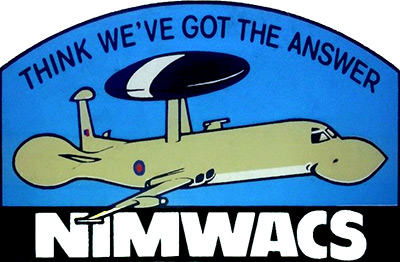
...if you can't take a joke...
As the first production AEW.3 was delivered to the RAF in 1984, the state of the radar and mission systems aboard were now glaringly obvious to the customer, rather than hidden behind manufacturer reports. It all blew up into a national scandal with newspaper articles and TV programmes exposing the whole sorry saga to the public. After a frustrating couple of years of in-service trials, and just as GEC/Marconi were claiming that the clutter issues were resolved, the entire project was cancelled in 1986. Nearly a billion pounds had been spent - with nothing to show for it. The RAF ended up buying E-3 AWACs after all, though they didn't enter service until 1991 and the poor old Shackletons had to soldier on until 1989.
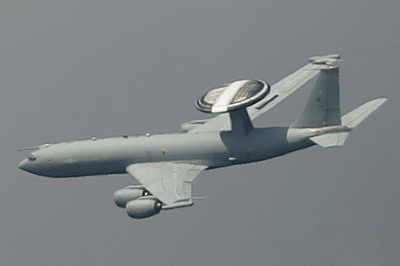
E-3D Sentry at Kemble, June 2008; Damien Burke
Back to April 1982, though, which saw the hurried deployment of Nimrod MR.1s to Ascension Island in support of the Task Force that was steaming to retake the Falklands from invading Argentine forces. The MR.1s were soon relieved by MR.2Ps - hastily fitted with inflight refuelling probes above the cockpit (and a small dorsal fin and finlets on the tailplanes to correct the resulting directional instability). They then patrolled the vastness of the South Atlantic ahead of the Task Force, searching for any Argentine naval presence - particularly their submarines. They also provided SAR cover for the Victor tankers and Vulcan bombing raids during the war, acted as comms relays and even trained to drop bombs - thankfully a task they weren't then required to carry out.

Nimrod MR.2s at Ascension during the Falklands War; RAF
After a Nimrod encountered one of its opposite numbers in the Argentine Air Force - their Boeing 707 reconnaissance aircraft - the type was even fitted with AIM-9G Sidewinder missiles, amidst much publicity, which would hopefully make short work of any unlucky future 707. Fortunately for the 707 crews (and possibly because they knew the world's biggest fighter now patrolled the South Atlantic), there were no further encounters. Anti-submarine work at the time included searching for not only Argentine subs, but also keeping an eye on those of other nations - a Russian 'Charlie' class submarine being found and retiring to safety once the UK went on to announce that further submarine contacts would be treated as hostile.
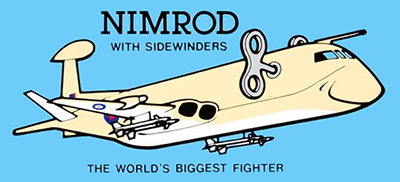
A small number of Nimrod R.1 sorties were also flown, only these were from Chilean territory amidst much secrecy, including night-time refuelling at Chilean Air Force bases. While much valuable signals intelligence was gleaned from the sorties down Argentina's western border, the risks of these clandestine missions were mounting so they were soon discontinued.
The hurried design of the inflight refuelling capability, which had taken serious risks at the time by routing the incoming pipework through the cockpit's upper escape hatch (thus disabling the hatch), and positioning a fuel blow-off valve where fuel could be vented into an engine intake was now looked at again to provide a safer permanent installation. The changes were not enough; analysis found that at least one of the other blow-off valves could result in fuel tracking back along the fuselage, potentially able to make its way inside through various intakes, vents or ports in the fuselage skin. Yet nothing was done to investigate further, and the seeds for the end of the Nimrod were sown.
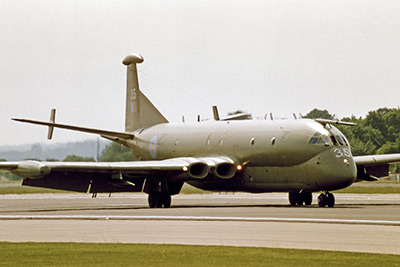
Nimrod MR.2 XV235 with BOZ107 pods, Boscombe Down, June 1992; Damien Burke collection
With the cold war winding down and the fall of the Berlin Wall in 1989, Soviet submarine activity dropped off the proverbial cliff, but there were new conflicts on the horizon. First up was the UN peace keeping operations in Bosnia, where the Nimrod force played a part in patrolling the Balkans. The 1991 Gulf War found the Nimrod back in the front line, hastily equipped with a new electro-optical turret and new self-protection measures including a towed radar decoy and underwing BOZ chaff/flare dispensing pod. However, at least one Nimrod crew found themselves desperately trying to escape an apparent trailing fighter - their own decoy! Over 400 sorties were flown by Nimrods based both in Oman and Cyprus, the latter providing cover for shipping bound for the Suez canal and the former looking for Iraqi naval activity in the Gulf. Anything they found was reported to other coalition assets for destruction.
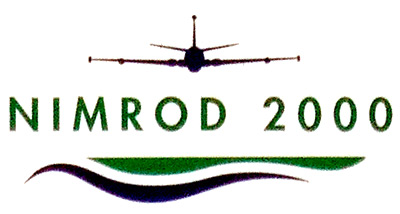
By the early 1990s there was a need for further upgrades to the Nimrod to cope with the rather different conflicts it was now encountering, and even incorporate some capabilities previously the forte of the R.1 force. Incredibly, despite the lessons of the AEW.3 debacle, the spec - ASR 420 - was another shopping list of the all-singing, all-dancing variety. 'Nimrod 2000' (as it was initially named) would have nearly double the range of an MR.2, with modern new engines, almost entirely new avionics, a new modernised cockpit based on the A330 airliner, and support for a whole new array of surveillance and offensive equipment. However, the preferred new engine was much larger than the existing Spey, so this was to be a much larger upgrade than that from MR.1 to MR.2. In fact, a largely new wing was necessary; and a new tail... and new undercarriage. Couple that with a new cockpit, and it was little wonder that the preferred option at BAe was to build new airframes, but to save money, the choice was made to re-use the fuselages from MR.2s. "Maritime Comet 2000" then, in reality.
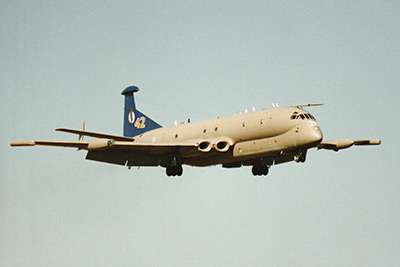
Nimrod MR.2 XV228 in 42 Squadron 75th anniversary colours, Waddington, June 1999; Damien Burke
Nominated MR.2 airframes were retired, stripped of equipment and dismantled. The fuselages were then flown inside an Antonov transport to FRA/Serco at Bournemouth airport for them to carry out work on relifing the fuselages and make sure they were fit for another 25 years of flight (BAE's Woodford, ex Avro, plant quoted for the work, but were undercut - alarm bells should have rung there, as they knew what they were going to be dealing with). Whilst jig-built in the 1960s, each MR.2 fuselage was slightly different from her sisters, particularly in the alignment of fuselage frames. The new structures designed with modern CAD/CAM systems were, of course, going to be identical and built to specific tolerances, though contrary to popular belief this mismatch did not come as a sudden surprise to the project team. In fact much work was put into making sure there was appropriate latitude in attaching the wings and associated systems, but there were delays involved, particularly with hydraulic runs and electrical looms, which all had to made to measure. In combination with FRA/Serco running behind schedule with costs rising and BAe having to take this part of the project on themselves, Nimrod 2000 was already looking like it was going to be Nimrod 2002 - or 2004.
The 1998 defence review then put the RAF into the difficult position of being required to make massive cuts just before a whole slew of new operations were on the horizon, and with what was looking like an ever-more expensive major project underway. Before the Nimrod 2002, 2003, 2004 jokes began, the new variant was renamed Nimrod MRA.4, the 'A' indicating a much-expanded attack capability (adding Hellfire, ALARM, Storm Shadow etc. to the already formidable array of weapons that Nimrods could deliver). Problems multiplied, including issues with the weight of the wings requiring prolonged redesign. Assembly of the first complete airframe did not begin until September 2000, but BAE had run into production capacity issues because of the delays to date (most of their resources now busy with Typhoon production) and so it was not until August 2004 that the first MRA.4 finally took to the air, a build period longer than the initial development and build of the Nimrod MR.1. To BAE's dismay, the aircraft looked right - but it didn't fly right. The aircraft had suffered an uncommanded pitch up during the take-off roll and as the test pilot eased into a turn he found the aircraft responding poorly. Two hands on the yoke and significant force were necessary to produce enough aileron deflection, and yaw stability was unacceptably low. Something had gone badly wrong in the redesigned wing and control runs. The test flight was, however, announced as a success, with the aircraft performing "as expected" - because there had been predictions of high control forces.
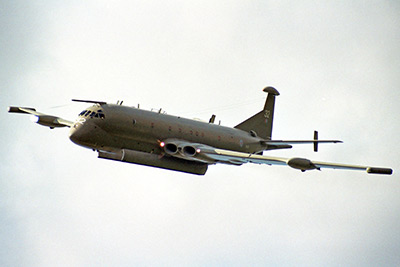
Nimrod MR.2 XV232 with weapons bay open, Fairford, July 2002; Damien Burke
Meanwhile, Nimrods, both MR.2s and R.1s, returned to the Middle East for the 2003 Iraq War, this time mostly in an overland capacity using their next new toy - the WESCAM MX-15 electro-optical system, hung from a wing pylon. With this the crew had an unrivalled view of potential ground targets by both day and night, so could act as a kind of Forward Air Controller, while the R.1s snooped on enemy threats and called them out to coalition forces. In fact the MX-15 was superior to the similar system specified for the MRA.4. The intention was to hunt for the mythical "weapons of mass destruction" - of course, there were none to be found. Soon the Nimrod force were reduced to being an airborne CCTV operation, and in the postwar period were even to be found carrying out such mundane tasks as monitoring power lines for thieves attempting to steal them for the valuable copper. Not exactly the best use of such an expensive asset! However, when ground forces needed an "eye in the sky" the Nimrod crews soon became first choice to call in, and increasing cooperation with the army would be the Nimrod's major calling from then on.
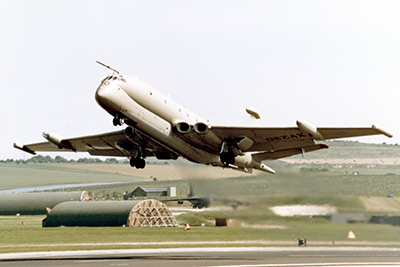
Ill-fated Nimrod MR.2 XV230 taking off from Boscombe Down, June 1992; Damien Burke collection
Afghanistan was, sadly, to become a place memorable to the Nimrod force for all the wrong reasons. With continuing use of the type for overland surveillance and ground force cooperation, the RAF's Nimrod crews had become used to deployments to coalition airfields in the country, and were busy supporting operations against the Taleban (Operation Herrick) on a nearly continuous basis. The design flaws introduced by the combination of modifications made over the years and complacency in authority with regards to the safety of the type all came together just minutes after Nimrod XV230 had refuelled from a tanker on the morning of 2nd September, 2006. Unknown to the crew, overflow fuel had collected in the bay through which the SCP duct ran, soaked into the duct's insulating wrap and had been ignited by the high temperatures. No fire alarm was triggered, for the bay was still not a designated fire zone and had no fire warning circuit. For the same reason, no extinguishing was possible. The blaze took hold and spread to the weapons bay and rear fuselage, finally breaching a fire detection circuit in the weapons bay, the first chance the crew had to know they were in trouble. The pilots began an emergency descent and made a Mayday call, but just over 6 minutes after their first indication of trouble, the blaze had heated the fuel tanks to boiling point and the aircraft exploded. All 14 on board were lost.
The only previous loss of a Nimrod and all on board had been from a mishandled air display routine; such heavy loss of life in Afghanistan gained much greater attention, and coupled with the ongoing delays and cost increases of the Nimrod MRA.4 programme, it was clear to the government that this was one scandal they could not sweep under the carpet. A full report into the loss of XV230 was commissioned.
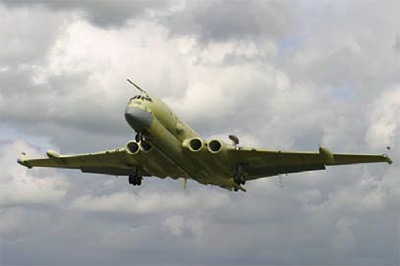
MRA.4 first flight; BAE Systems
The MRA.4 programme, meanwhile, staggered onwards, with the numbers of aircraft being ordered reduced first from 21 down to 18, then down to just 9 plus 3 prototypes. Nimrod 2000, now 6 years late and 50% over budget, was in serious trouble. BAE had wanted to pause production to give them time to fix other issues and avoid putting into production an aircraft that would need expensive rectification; the MoD wanted to use the pause to add more icing to the cake and asked for extra capabilities. The second aircraft had flown in December 2004, but the third did not fly until August 2005. Unlike the AEW.3 programme, the mission systems and software were looking to be much more effective, but the airframe itself proved problematic with large numbers of fiddly faults cropping up on a regular basis to add to the serious aileron and yaw stability problems. It would be 2007 before the aircraft's control and stability issues were finally fixed, after two major redesign efforts and the addition of a stability augmentation system.
In 2006 the MoD also began a project to extend the life of the Nimrod R.1 and give it additional capabilities - Project Helix. This was to extend the highly valued R.1 fleet's life through until around 2025 with a relatively cheap upgrade programme (£400 million for the 3 aircraft) that would look at ground support and training as well as upgrading onboard systems. BAE's bid for this work failed, and Lockheed-Martin were given the nod. However, in 2007, BAE pushed for the use of three MRA.4 airframes to do the job of the R.1, and cast doubts on the feasibility of upgrading the R.1s. By this point it had been decided not to finish off the 3 MRA.4 prototypes to production standard, and BAE suggested they could be completed as R.1 replacements instead. This backfired badly, as trust was now also lost in the project to upgrade the R.1, and the government immediately began investigating the prospect of buying RC-135 'Rivet Joint' aircraft from the USA instead - despite the fact that these were themselves 40 year old aircraft requiring larger crews and with a shorter planned life than the MRA.4.
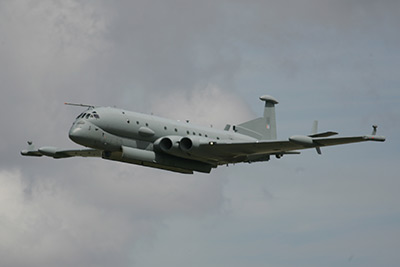
Nimrod MRA.4 ZJ518 with weapons bay open, Fairford, July 2007; Damien Burke
Then came October 2009, and the publication of the 'Nimrod Review' - the report on the loss of XV230. It proved to be an absolute bombshell, ripping into BAE, the RAF and the MoD in equal measure - the loss of XV230 was 'a failure of leadership, culture and priorities'. At heart, the RAF had been required, from 2002 onwards, to produce a 'safety case' for each aircraft. The one produced for Nimrod had been 'essentially a paperwork and tickbox exercise', Nimrod was 'safe anyway' (with 30 years of flight behind it) and the safety case was riddled with errors and missed key dangers. By this time, Nimrod MR.2s had already ceased air to air refuelling after another mid-air fuel leak scare, and by rights they should already have been withdrawn from service and replaced by the MRA.4, but of course with MRA.4 running years late, the MR.2s were soldiering on.
The impact of the report has had major ramifications for the RAF ever since, but, coupled with the cost overruns, it also spelled the end for both MR.2 and the MRA.4. The much-postponed retirement of the MR.2 force, by this point slated for 2011, was now brought forward to March 2010, with a number of the remaining fleet being flown into preservation at various sites throughout the UK in the months after retirement. After retiring one R.1 late in 2009 to use as spares for the remaining pair, the government announced in March 2010 that they would indeed be ordering RC-135s to replace the R.1, and would retire the R.1 "immediately" - though this was then extended to May 2011 as the R.1 was needed to support operations in Libya. March 2010 also saw the first production MRA.4 airframe made available to the RAF - being formally handed over at Woodford on the 10th. It would soon be flown to Warton where the RAF would be working up the first crews.
The Military Airworthiness Authority then audited the MRA.4 project in April 2010 and found that there were significant gaps in the safety documentation and associated decision making throughout the project's life. Their conclusions found that the project was likely to continue to suffer further delays, and required urgent attention to address the safety issues. A further report later in the year listed hundreds of safety related defects that had still to be dealt with, including a section of hot air ducting without insulation - something unacceptable under design regulations at any time, let alone after the disastrous loss of XV230. The much-redesigned control system also placed a vital control run in a position within the weapons bay that could be vulnerable to a bird strike with the bay doors open, something that would then render the aircraft uncontrollable. It was clear that the safety case for MRA.4 - which was already partly based on the clearly faulty MR.2 safety case - was going to be a huge challenge; there were many legacy decisions to unravel, and it would cost a lot in time and money to dig through the entire project history to prove that the new version was airworthy to modern standards. Then, of course, there were the amount of modifications needed to fix the outstanding issues.
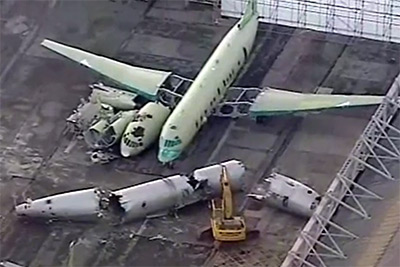
Nimrod MRA.4s being scrapped, Woodford, January 2011; BBC
On 19th October 2010, in the infamous 2010 defence review, the MRA.4 project was abruptly cancelled, the published reasoning at the time being to save the money that would be spent on the project in the future, with the government only stating some years later that it was unlikely to have ever met safety standards. "Nimrod 2000" was now 10 years late and 100% over budget but with the first production airframe in RAF hands and an initial operational capability date less than 2 years away, it seemed to many to be an incredible decision to have made. With the MR2 already retired, it also left the UK without a maritime patrol aircraft for the first time since the start of WW2, and £4 billion was gone with nothing to show for it. The frustration within the RAF at squadron level was palpable - they felt as they'd just lost the world's best MPA before it had a real chance to prove itself. In the higher echelons, though, the sense of relief that the saga was finally over and done with was obvious.
In early 2011, after unsuccessful attempts to offer some airframes to museums, BAE scrapped all of the MRA.4 airframes then under production or completed at their Woodford plant. The mass scrapping was carried out behind screens intended to hide the destruction but that didn't stop helicopters taking photos. It also spelled the end for Woodford, which closed a year earlier than planned, in August 2011. The site has since been razed and is being built on for housing. The remaining pair of R.1s continued operations until June 2011 (an extra month extension on the date planned due once again to operational requirements), with both aircraft being flown into preservation the next month. The R.1 would end up being replaced by Boeing RC-135W Rivet Joint (or "Airseeker") in 2013 after a "capability gap" of 2 years.

Poseidon MRA.1 ZP801, North Sea, August 2020; RAF
Incredibly it took another five years after the MRA.4 cancellation for the MoD to announce that it would be buying 9 Boeing P-8 Poseidons from the USA (another MPA based on an airliner design, as they are basically Boeing 737s with attitude). The first aircraft entered service with the RAF in 2020, 10 years after Nimrod MR.2 had been retired. Those 9 aircraft have a lot of RAF history to carry forward - not least the 41 years of sterling service provided by The Mighty Hunter.
One final twist of fate for the story - while AEW.3 was replaced by the Boeing E-3 Sentry, the Sentry has now also come to the end of its useful life in the RAF. Nobody suggested rebuilding any Nimrods for a successor this time, so the RAF are buying yet another American product, the Boeing E-7 Wedgetail (with the order already reduced to just 3 from the original 5 at the time of writing). A purpose designed, sparkly new bit of kit? Not on your nelly. They are, just like Nimrod, converted airliners - the RAF's first E-7 is being converted from a 10 year old Boeing 737 bought back from a Chinese business jet outfit. One assumes the safety case will be rock solid...
Leading Particulars
| Variant | MR.1 | R.1 | MR.2 | AEW.3 | MRA.4 |
|---|---|---|---|---|---|
| First flight | 24h May 1967 | 21st October 1973 | April 1977 | 16th July 1980 | 26th August 2004 |
| Crew | 11 or 12 | 7 to 31 | 11 to 18 | 10 to 12 | 10 |
| Armament | 2 pylons and 20,000lb capacity bomb bay; Nord AS-12, Martel missiles, depth charges, B-57 nuclear depth bombs, Stingray torpedoes, mines | Nil | 2 pylons and 20,000lb capacity bomb bay; AIM-9G Sidewinder, Nord AS-12, Martel, AGM-65 Maverick, AGM-84 Harpoon, Sea Eagle missiles, depth charges, B-57 nuclear depth bombs, HE bombs, Stingray torpedoes, mines | Nil | 4 pylons and 22,000lb capacity bomb bay; AIM-9L Sidewinder, AGM-65 Maverick, AGM-84 Harpoon, Storm Shadow missiles, Stingray torpedoes, mines |
| Powerplant | 4 x RR Spey 250 turbofans | 4 x RR Spey 251 turbofans | 4 x RR Spey 250 (later 251) turbofans | 4 x RR Spey 250 turbofans | 4 x BMW/RR BR-710 turbofans |
| Max. speed | 498 kt | 304 kt | 496 kt | ||
| Service ceiling | 44,000 ft | 36,000 ft | 42,000 ft | ||
| Range | 5180 nm | ? | 6910 nm | ||
| Empty weight | 86,000 lb | ? | 86,000 lb | 86,000 lb (?) | 102,515 lb |
| Max. take off weight | 177,500 lb | ? | 192,000 lb | 187,800 lb | 232,315 lb |
| Wing span | 114 ft 10 in | 115 ft 1 in (with ESM pods) | 127 ft | ||
| Wing area | 2,121 sq ft | 2,538 sq ft | |||
| Length | 126 ft 9 in | 119 ft 9 in (with AAR probe) | 129 ft 1 in (with AAR probe) | 137 ft 8.5 in | 126 ft 9 in |
| Height | 30 ft | 35 ft | 31 ft | ||
| Production | 48 (inc 2 prototypes) | 4 (inc 1 MR.2 conversion) | 35 (all but 1 MR.1 conversions) | 11 (all MR.1 conversions) | 9 (all MR.2 conversions, only 5 completed) |
